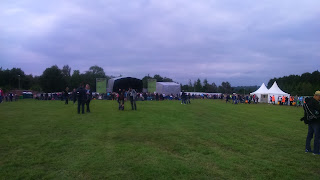Last night I attended the Annual General Meeting of the
British Guild of Beer Writers. I have been a member of the guild for nearly two
years, but this was the first formal meeting of the organisation I have been
along to.
The AGM took place at the
historic George Inn, which is just off Borough High Street and just a short hop from London
Bridge station. The 6.30pm start gave me just enough time to get
home from work, change my shirt and then hot foot it down to Tonbridge station
and jump on a London-bound train.
The meeting was held in the Winchester Room, which is at the
far end, and on the upper floor of this lovely old coaching inn. This was the
first time I have been upstairs at the George, and it was nice to experience a
bit more of the pubs history, at first hand. For those not in the know, the
George is the last remaining example of the many coaching inns which were once
present south of the river, and is the only remaining galleried inn in London.
 |
| The George Inn |
The building dates from 1677, and has obviously seen many
changes and witnessed many comings and goings in its long history, but today it
still offers hospitality to visitors in the form of good food and drink,
although it no longer offers lodging for travellers or stabling for horses. The George was originally constructed with two wings and a
rear, which flanked a central courtyard, but unfortunately the section on the
north side, along with that at the rear, was pulled down in the 19th
Century by the Great Northern Railway, who used the pub as a goods depot. Today
only the southern section remains. The George Inn is owned by the National Trust,
who lease it out to Greene King; and it is the latter company we have to thank
for their hospitality last night.
 |
| The only remaining galleried inn in London |
And so to the meeting, which was presided over by Guild Chairman, Tim Hampson, Treasurer, Paul Nunny and Secretary Adrian Tierney-Jones. Also present were many luminaries from the world of beer writing, including Good Beer Guide Editor, Roger Protz, leading beer historian, Martyn Cornell, London’s Best Beer, Pubs & Bars author, Des de Moor, CAMRA Founding Member, Michael Hardman and much published beer writer, Pete Brown. There were a number of fellow writers and Bloggers who I have got to know over the past couple of years, including Peter Alexander (Tandleman), Matthew Curtis, Bryan Betts and Ed Wray.
 |
| Adrian receiving his presentation |
There was a ballot to elect seven ordinary committee members to join the chairman and treasurer in steering the guild towards a new future. This is because the BGBW is changing this year from a private member’s club to a limited company. There was also a change on the top table, with Adrian Tierney-Jones standing down as secretary after 11 years in the role. During his time as Guild Secretary the membership, scale of activity and reputation of the Guild has grown out of all recognition, which is a tribute to enormous amount of hard work that Adrian has put in over and above his day job.
In order to take the Guild to the next level the committee have decided to recruit a secretary to work one day a week for the organisation, but before Adrian officially stepped down, Chairman Tim Hampson led the tributes and thanks for all his hard work over the years and presented him with a bound set of Alfred Barnard’s “The Noted Breweries of Great Britain & Ireland”.
With the formal stuff over, the meeting ended and we got stuck into a rather nice finger-buffet, along with more beer. This was obviously where the bulk of the socialising took place, and it was good to catch up with people and to hear about some of their experiences as writers in the multifaceted world of beer. As I mentioned earlier, it was good to meet up with Ed Wray for the first time, but it was also good to chat with Bryan, Matthew and Peter. Tandleman had just got back from a holiday in Albania, and was dressed as though he had literally just stepped off the plane!
I left, shortly after 10pm, as with the concluding part of a four day audit, at work, conducted by the US Food & Drug Administration, due the following morning I needed to keep a (relatively) clear head. I enjoyed my introduction to the Guild and its workings, and to meeting some new faces.
I have already pencilled in a few dates in my diary, including the organisation’s annual pre-Great British Beer Festival get-together which, this year, takes place upon the Tattershall Castle paddle steamer, and the Guilds Annual Awards Dinner, at the beginning of December.






















